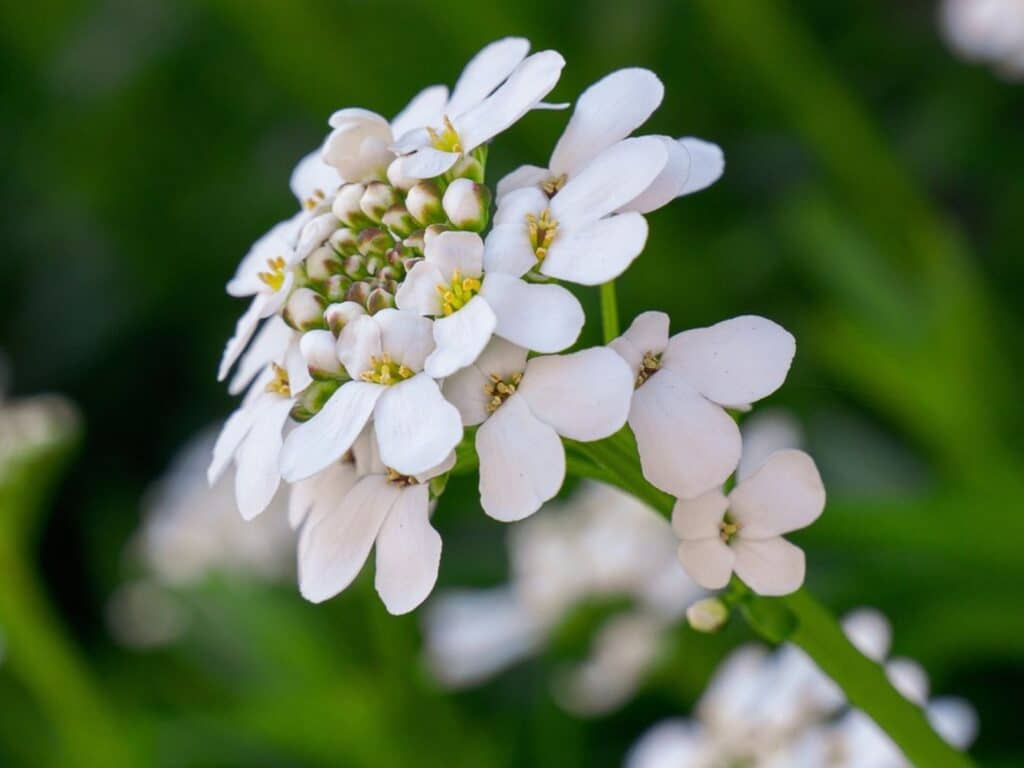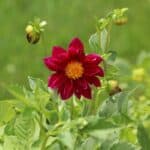Candytufts (Iberis) is a beautiful flowering plant that can add color and cheer to your garden spaces. This spring-blooming flower will look charming if you grow it in containers on a sunny patio, but it can also be used to form hedges along walkways because it produces shrubs with lots of blooms.
Candytuft belongs to the Brassicaceae family. This perennial flower produces tiny clusters of fragrant flowers in various colors like pink, purple, and white. There are also different varieties of this plant, including dwarf varieties (Iberis ‘Dwarf Fairyland Mixed’) that are excellent ground covers or tall types (Iberis gibraltarica) that can be used for showy hedges.
You can mix different varieties and colors of Candytuft to create vivid gardens. Still, lots of gardeners prefer to combine these flowers with other plants to accentuate their beauty and enhance their functionality.
Some of the best companion plants for Candytuft include plants like petunias, Angelina stonecrop, lilac bushes, yellow alyssum, or veronicas because these plants have similar growing needs, they are identical in height, and they all produce lots of vivid blooms.
In this guide, we will take a closer look at these candytuft companions and discuss creative ways to use them in your garden.
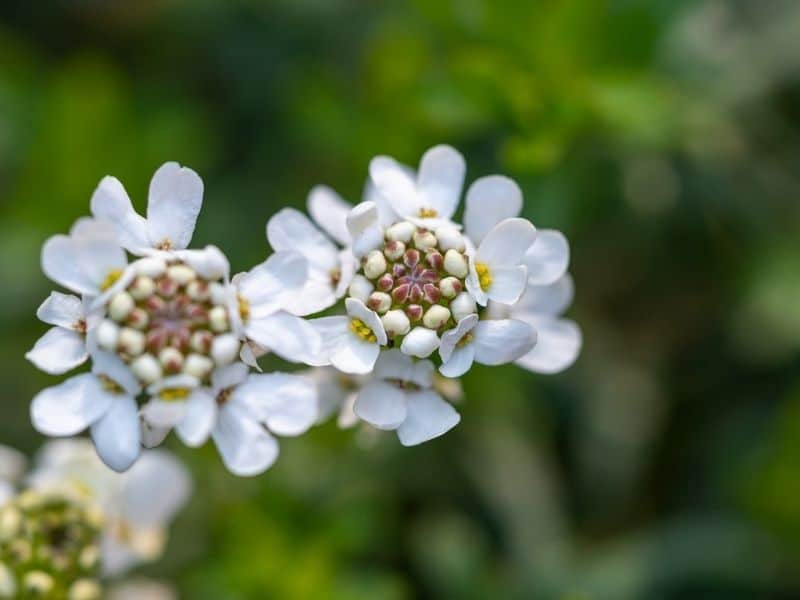
What to Grow with Candytuft
If you want your candytufts and companion plants to grow healthy and strong, then it is essential to position them in a suitable location and pair plants with similar growing needs.
Candytufts will produce many bright blooms if placed in a full sun position, but they can also grow well in dappled shade.
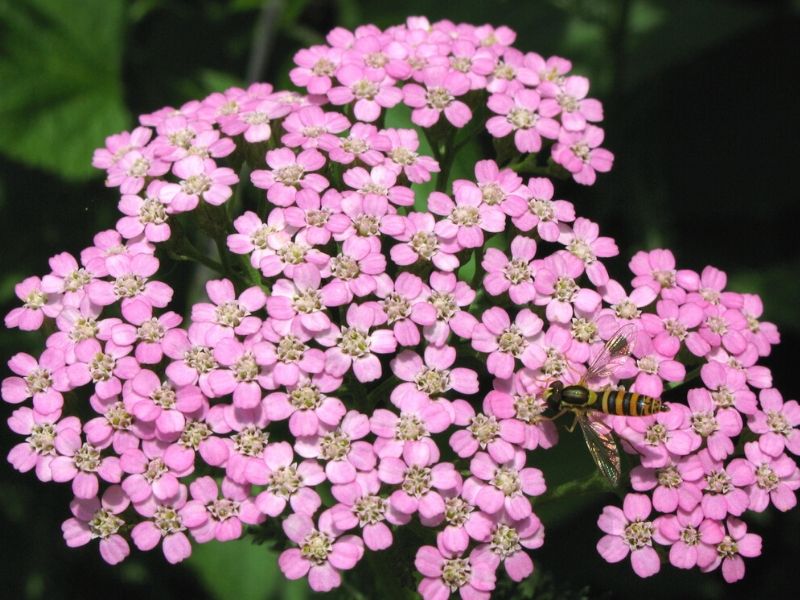
This plant needs frequent watering since it prefers moist soil that drains well, but once established, these flowers can be somewhat drought tolerant. These flowers prefer slightly alkaline soil types, and it is best to add a layer of mulch on top of the soil so the roots will be protected from frost during its dormancy stage.
Let’s look at some companion plants that look striking next to Candytuft and can grow well in full sun, light shade, and moderate watering.
Petunias
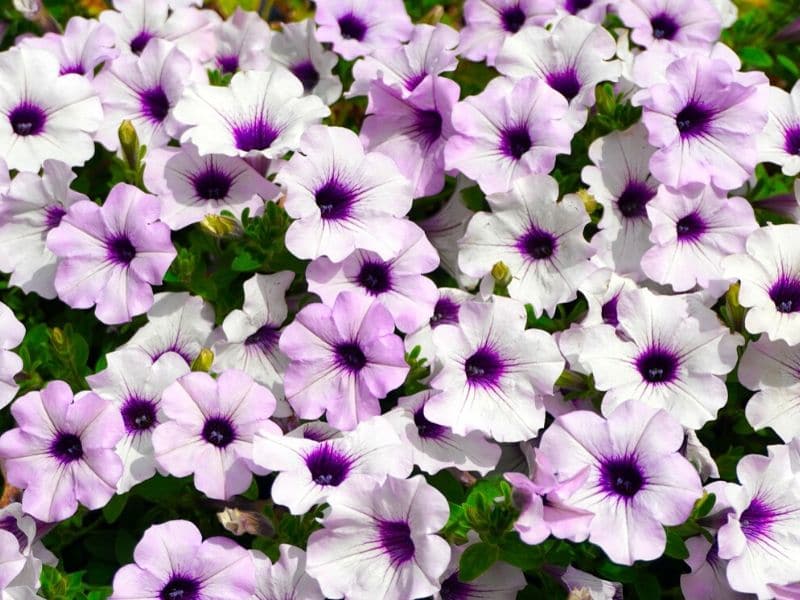
Petunias (Petunia) is one of the most popular flowering annuals found in ornamental gardens because they have a long flowering period, produce an abundance of vivid blooms, and come in many different colors.
With their striking blooms, these flowers are ideal garden fillers to pair with dwarf Candytuft because they only grow up to 18 inches tall. You can also use them as a ground cover or barrier plant in front of taller varieties of Candytuft.
These two plant species will flourish next to one another because both require lots of direct sunlight and well-drained soil and are semi-hardy. Together, the vivid flowers and fragrant blooms will attract lots of pollinators to your garden, creating a showy display of bright colors.
Angelina Stonecrop

Angelina stonecrop (Sedum rupestre ‘Angelina’) can be a great companion plant for Candytuft in dry and rocky gardens. This evergreen perennial has succulent foliage in bright lime green to orange colors that can accentuate the color of your candytuft blooms.
These succulents will grow well in any sandy, gravel, or rocky soil type and can be very drought tolerant. They do, however, require lots of direct sunlight to grow well.
Stonecrops can quickly spread all over your garden bed and act as a living mulch to protect the other plants. If you grow lots of stonecrop in your garden with some dwarf candytuft peeking out all over, it will create a colorful effect with lots of contrast between the blooms, foliage, and rocky features.
False Rock Cress

False rock cress (Aubrieta spp.), also known as lilacbush or rainbow rockcress can look striking next to Candytuft because this low shrub will form a thick mat with lots of vivid purple or red flowers all over your garden bed.
Rock cress is semi-evergreen with greyish-green foliage that can contrast your garden beds even when they are not in bloom.
This vigorous plant can be a great ground cover or garden filler to pair with dwarf Candytuft, or you can grow it in front of taller candytuft varieties.
Gardeners should be careful to position rock cress where they will receive plenty of sunlight because they can become leggy if they are planted in too much shade.
Basket-of-Gold

Basket of gold flowers (Aurinia saxatilis) also known as yellow alyssum or sweet alyssum is an ideal companion plant to grow with Candytuft if you want to add lots of contrast to your garden. The vivid yellow blooms are bound to form a striking contrast with the yellow, white, or purple candy tufts.
Many people mistake alyssum flowers for Candytuft because of some similarities between their flowers and plant height. The flowers of alyssums are less showy than those of Candytuft, and these perennials prefer more moisture and shade, while Candytuft prefers dryer and warmer conditions.
Yellow alyssums are spring-blooming perennials that will flourish in well-drained sand or rocky soil, but it might be good to grow them in the areas of your garden that receive a little bit more shade.
Veronicas

Veronicas (Veronica), also known as speedwells, bird’s eye, or gypsy weeds, are good companions for Candytuft. There are over 250 varieties of this plant, which can significantly vary in size and flower design.
Low-growing types can be great ground covers to position alongside dwarf candytuft in rocky gardens, but if you want to add lots of texture to your spaces, it is best to get wooly speedwells with their tall, spiky flowers.
These charming flowers will add lots of color to your garden from spring to fall. They will grow well in most soil types and are relatively drought-tolerant. Veronicas prefer full sun positions but can grow well in partial shade.
What NOT to Grow with Candytuft
Candytuft is a pretty flexible plant since it can grow in full sun to light shade and it can tolerate moist to drought conditions. Because of its flexible nature, it can grow well with a variety of plants. There are, however, some species that won’t grow well in the same area as Candytuft.
Candytuft is drought and heat tolerant but it doesn’t take well to cold climates and the plant doesn’t like wet roots. It is usually best not to grow it with shade-tolerant species like begonias, hostas, ferns, peace lilies, or anthuriums because these plants will become scorched in warm and sunny areas.

Landscaping Ideas for Candytuft
Candytuft is popular in cottage gardens, cutting gardens, rock gardens, and rock walls. It is an ideal filler plant because it creates dense growth with lots of blooms. Here is a quick look at some of the most popular ways to use this beautiful flowering plant.
Rock Gardens
Candytuft and the companions we mentioned here grow well in rocky and sandy soils. They will look striking in gardens with lots of rocky features and can be mixed and matched all over your sunny rocky patches or grow in rocky walls to create an interesting display of hard and soft elements.
Xeriscape Projects
In water-efficient gardening projects or xeriscape gardens, you can use candytufts and other hardy companions like veronicas, false rock cress, stonecrop, or petunias. These flowers only need water once a week and are great for adding color to dryer landscaping projects.
Patio Containers
Candytufts and the other plants we discussed here will grow well in containers and are ideal for decorating a sunny patio. Plant these flowers in garden pots with potting soil and place them where they will receive lots of early morning to late afternoon sun.
Final Thoughts
Candytufts will look even more stunning if you grow them alongside other vivid blooming plants like petunias, rainbow rockcress, sweet alyssum, or veronicas. You can combine them with bright-toned succulents like stonecrop. These plant combinations are ideal for adding lush growth and bright color to your garden.
We hope you enjoyed our companion planting guide and got plenty of fresh ideas for different ways to use and combine candytufts.
See more:
Image by Kris.Rad – nahhan/depositphotos

